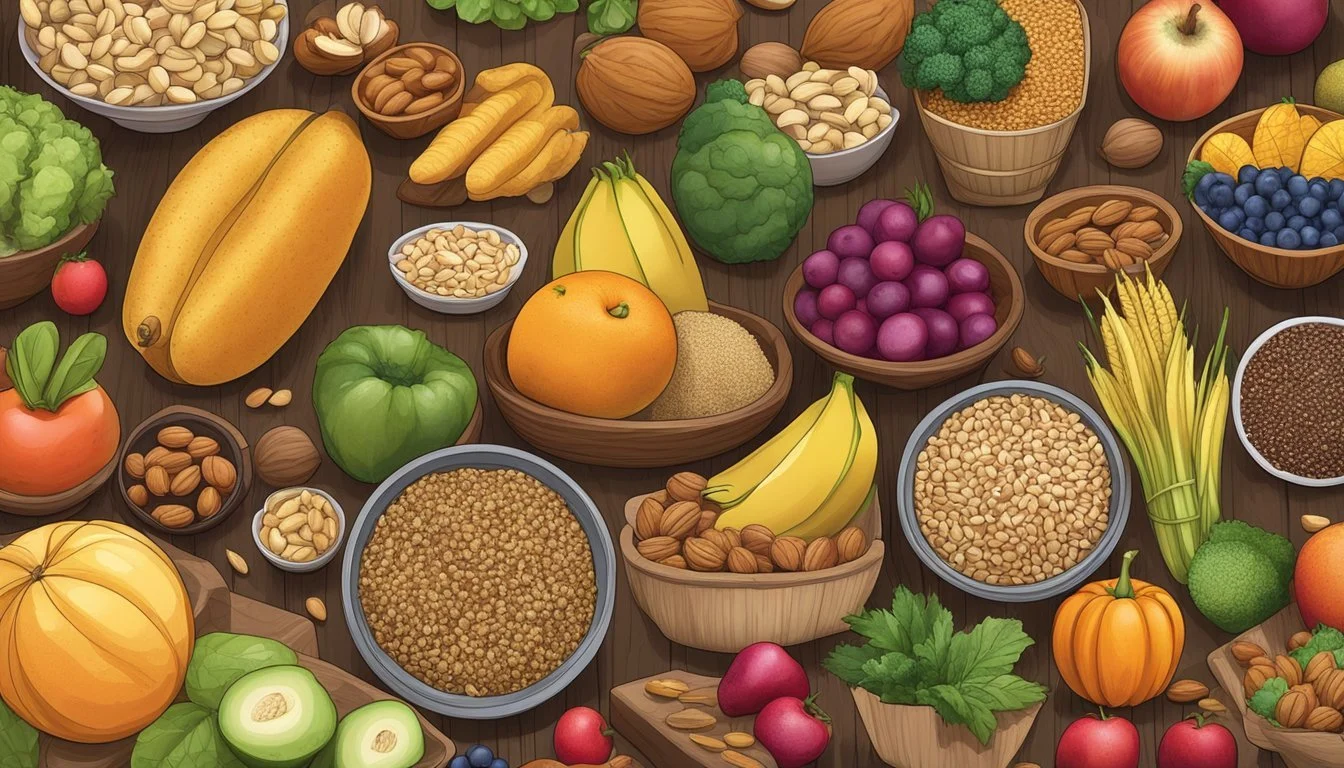The Best Paleo Diet Tips for a Flat Belly
Essential Strategies for Optimal Results
The Paleo diet harks back to our hunter-gatherer ancestors and focuses on consuming the types of foods presumed to have been eaten during the Paleolithic era. This diet primarily includes lean meats, fish, fruits, vegetables, nuts, and seeds — foods that in the past could be obtained by hunting and gathering. The philosophy behind the Paleo lifestyle is rooted in the belief that modern eating habits are discordant with our genetic makeup and are contributing to health problems such as obesity, diabetes, and heart disease.
Achieving a flat belly is a common health and fitness goal, and it is often pursued through various diet and exercise regimens. However, belly fat can be particularly stubborn; it requires not only a healthy diet and regular exercise but also a strategic approach to meal composition. While the Paleo diet does not target belly fat specifically, its emphasis on whole foods and elimination of processed items can contribute to overall fat reduction and improved metabolic health, which in turn may lead to a flatter stomach.
To harness the potential belly-flattening benefits of the Paleo diet, it’s vital to choose foods that support digestive health and reduce inflammation. High-fiber vegetables such as asparagus, which also have diuretic properties, can be beneficial. Staying hydrated, preparing big batches of Paleo-friendly meals, and avoiding overeating play significant roles in maintaining a healthy weight and promoting a leaner midsection. The Paleo framework encourages one to eat mindfully and to consume nutrient-dense foods that can support the body's natural processes to achieve and maintain a flat belly.
Understanding Paleo Diet Fundamentals
The Paleo Diet revolves around the concept of emulating the dietary patterns of our hunter-gatherer ancestors. It emphasizes whole, unprocessed foods and excludes modern processed items.
Defining the Paleo Diet
The Paleo Diet is modeled after the diets presumed to have been consumed by hunter-gatherers. It focuses on the intake of foods that could be obtained through hunting and gathering, including lean meats, fish, fruits, vegetables, nuts, and seeds. These types of foods are believed to work with human genetics to promote health and well-being. It typically excludes dairy, grains, and legumes.
The Role of Whole Foods
Whole foods are the cornerstone of the Paleo Diet. They are characterized by minimal processing, which retains the foods' natural nutrients without additives or preservatives. Here's a breakdown of whole foods on the Paleo Diet:
Fruits and Vegetables: Rich sources of vitamins, minerals, fiber, and antioxidants.
Lean Meats and Fish: Provide essential proteins and omega-3 fatty acids.
Nuts and Seeds: Offer healthy fats and are a great source of energy.
Consuming organic produce is encouraged, to reduce exposure to pesticides, though it's not mandatory for following a Paleo lifestyle.
Eliminating Processed Foods
Processed foods are typically high in calories, sugar, unhealthy fats, and artificial ingredients, contributing to weight gain and health issues. The Paleo Diet advises against the consumption of such foods. Instead, it endorses foods that would have been available in the Paleolithic era, which naturally excludes modern processed items:
Dairy: Often replaced by plant-based alternatives.
Grains: Especially those with gluten, are avoided as they were not part of the Paleolithic human's diet.
Sugar: Natural sweeteners like honey or maple syrup are used sparingly.
By eliminating these processed foods, proponents of the Paleo Diet argue that one can achieve a healthier and potentially flatter belly, thanks to the diet's emphasis on whole, unprocessed foods.
Key Nutrients for a Flat Belly on Paleo
Achieving a flat belly with the Paleo diet hinges on the careful selection of nutrient-dense foods that support digestion and metabolism.
Importance of Fiber and Protein
Fiber is essential for digestive health and keeping hunger at bay. Its role in the Paleo diet is pivotal for not only promoting satiety but also for maintaining a flat stomach. Rich sources of Paleo-friendly fiber include leafy greens and cruciferous vegetables like broccoli and Brussels sprouts.
Protein, on the other hand, is crucial for muscle repair and growth, which can aid in increasing metabolic rate. It helps manage appetite and is found abundantly in lean meats, such as chicken and turkey, and in seafood. Regular intake of eggs and nuts and seeds also provides a good protein boost.
Selecting Healthy Fats
Healthy fats are an integral part of the Paleo diet and can be beneficial for weight management. One should focus on mono- and polyunsaturated fats which are found in avocados, olive oil, and fatty fish like salmon. These fats can help reduce inflammation and provide satiety to prevent overeating.
It is also recommended to include nuts and seeds in moderation as they are calorically dense but offer a good mix of fats and other nutrients.
Optimizing Carbohydrate Intake
While the Paleo diet restricts high-carbohydrate grains, it is still important to obtain sufficient carbohydrates, especially for those who are active. Carbohydrates should primarily come from vegetables and fruits, with an emphasis on those with a lower glycemic index to avoid spikes in blood sugar.
Root vegetables like sweet potatoes and squash can be included as healthy, nutrient-dense sources of carbohydrates that support energy needs without compromising a flat belly.
Effective Paleo Foods for Weight Loss
To achieve a flat belly, incorporating certain paleo foods into one's diet can significantly contribute to weight loss. These foods are selected for their ability to promote fullness, maintain lean muscle, and provide valuable nutrients without excess calories.
Fruits and Vegetables for Satiety
Fruits and vegetables are fundamental for weight loss on the paleo diet due to their high fiber content, which increases the sense of satiety and helps prevent overeating. For instance, berries and leafy greens are low in calories but high in fiber.
Berries: Strawberries, blueberries, raspberries
Leafy Greens: Spinach, kale, Swiss chard
Consuming a variety of fresh fruits and vegetables ensures adequate vitamin and mineral intake while aiding in belly fat reduction.
Lean Meats and Fish for Muscle Maintenance
Lean meats and fish are not only rich in high-quality protein for muscle maintenance but also beneficial for weight loss because they help keep one full for longer. Choosing grass-fed meats and oily fish provides essential fatty acids and helps reduce calorie intake from less healthy fats.
Grass-Fed Meats: Beef, lamb
Oily Fish: Salmon, mackerel, sardines
Including these sources of lean protein helps maintain muscle mass during weight loss, ensuring the body burns fat rather than muscle.
Nuts and Seeds as Nutrient-Dense Snacks
Nuts and seeds are the perfect paleo snacks. They are packed with healthy fats, proteins, and fibers which contribute to a feeling of fullness. They should be eaten in moderation due to their high-caloric density.
Nuts: Almonds, walnuts
Seeds: Pumpkin seeds, chia seeds
Including a handful of these can curb hunger pangs without compromising nutritional goals.
Strategies to Reduce Bloating and Enhance Gut Health
The Paleo diet can be tailored to tackle bloating and promote gut health by identifying triggers and incorporating gut-friendly foods.
Identifying Common Causes of Bloating
One must first recognize that bloating can arise from various factors within a Paleo framework. Common culprits include:
Poor chewing habits: Ingesting unchewed food can lead to improper digestion, resulting in gas and bloating.
Rapid eating: Consuming food too quickly can cause one to swallow air, which contributes to bloating.
Overeating: Excessive food intake stretches the stomach and can create discomfort, as the gut struggles to process large amounts at once.
Foods that Promote a Healthy Gut Flora
The key to a healthy gut is a balanced diet rich in certain foods that aid digestion and promote beneficial bacteria. These include:
High-fiber vegetables: A sensibly selected array of vegetables can provide the necessary fiber to support digestion and reduce bloating.
Probiotics: Fermented foods such as sauerkraut are full of probiotics, which help maintain a healthy balance of gut flora.
By addressing eating behaviors and incorporating specific nutrient-dense foods, individuals can significantly improve gut health and minimize bloating on a Paleo diet.
Meal Planning and Preparation Tips
Efficient meal planning and preparation are paramount for adhering to the Paleo diet, which emphasizes whole foods for optimal nutrition and a flat belly.
Making a Balanced Paleo Meal Plan
A successful Paleo meal plan focuses on a variety of organic produce, lean meats, and high-fiber foods to ensure balanced nutrition. Individuals should aim to incorporate a diverse range of vegetables to maintain satiety and nutrient intake. Here's an example of what a balanced daily meal plan could look like:
Breakfast: Scrambled eggs with spinach and avocado.
Lunch: Grilled chicken salad with a rainbow of vegetables like bell peppers, cucumbers, and carrots.
Dinner: Lemon-baked salmon with asparagus and a serving of roasted butternut squash.
When constructing their meal plan, they should consider the following options for a well-rounded approach:
Meal Time Options
Breakfast Omelets, smoothies, fruit bowls
Lunch Salads, lettuce wraps, soup
Dinner Stir-fries, steaks, vegetable bakes
Paleo Friendly Snacks and Meal Prep
Snacking can be both satisfying and strategic in the Paleo diet. It's crucial for individuals to choose snacks that are not just filling but also compliant with Paleo principles. Examples include nuts and seeds, which are energy-dense and nutritious, as well as hard-boiled eggs which are a good source of protein.
Preparing meals in advance can save time and ensure adherence to the diet. They can roast a larger portion of lean meats and vegetables at the beginning of the week to use in various meals. It's beneficial to have prepped items like shredded chicken or beef, cut-up vegetables, and washed greens ready to go.
By following these meal planning and preparation tips, adherents of the Paleo diet can streamline their cooking process, ensure a consistent intake of nutrient-dense foods, and work towards their goal of a flat belly.
Lifestyle Considerations for Optimal Results
Adopting the Paleo diet is a step towards improved health, but for a flat belly, one must pair dietary changes with lifestyle adjustments. Focusing on sleep and hydration, along with consistent movement, can significantly enhance the diet's effectiveness in reducing body fat percentage.
The Importance of Sleep and Hydration
Sleep is crucial for weight management; a steady sleep schedule can aid in hormonal balance, which is essential for maintaining a healthy body fat percentage. Adults typically require 7-9 hours of quality sleep each night to support metabolic processes and recovery.
Hydration plays a pivotal role in digestion and maintaining bodily functions. Individuals following the Paleo diet should aim for:
At least 2.7 liters (91 ounces) of water per day for women
About 3.7 liters (125 ounces) daily for men
Maintaining this level of hydration helps manage hunger, increases metabolism, and aids in the detoxification processes crucial for a flat belly.
Incorporating Movement into Your Routine
Movement should be integrated into one's daily routine to support the Paleo diet's effects on reducing body fat. A mixture of aerobic exercises and strength training is recommended. For instance:
Aerobic activities (walking, jogging, cycling) for at least 150 minutes per week
Strength training exercises, targeting all major muscle groups, at least twice per week
Consistent movement not only burns calories but also improves muscle mass, which in turn boosts metabolism, helping to maintain a lower body fat percentage.
Managing Dietary Restrictions and Preferences
The Paleo diet, although based on a specific set of principles, can be tailored to accommodate dietary restrictions such as vegetarianism and lactose intolerance, as well as preferences like gluten-free living.
Customizing Paleo for Vegetarians or Vegans
Vegetarians and vegans can adapt the Paleo diet to align with their plant-based lifestyle by emphasizing nutrient-dense whole foods. They should focus on:
Vegetables and fruits: These are foundational to the Paleo diet and supply essential vitamins and minerals.
Nuts and seeds: Provides healthy fats and protein.
Gluten-free grains: Although not traditionally Paleo, some include them to increase carbohydrate intake.
Legumes: Often omitted, but vegetarians might opt for lentils or chickpeas as protein sources, soaked or sprouted to reduce antinutrients.
It's essential for vegetarians and vegans to ensure adequate protein intake, which is challenging when traditional Paleo protein sources like meat are not an option.
Addressing Gluten and Lactose Intolerances
Those with gluten intolerance can easily embrace a Paleo diet, as it naturally excludes grains, which are primary sources of gluten.
Key considerations:
Read labels carefully: Gluten is hidden in many processed foods and sauces.
Focus on gluten-free whole foods: Such as meats, seafood, and fresh produce.
For individuals with lactose intolerance, the Paleo diet can be suitable since it typically eliminates dairy products. However, if dairy is desired:
Opt for lactose-free dairy options, like aged cheeses (What wine goes well with aged cheeses?) and lactose-free milk.
Experiment with dairy alternatives, such as almond milk or coconut milk, which also provide the creaminess and flavor profile of traditional dairy.
Monitoring Progress and Making Adjustments
To ensure success on the Paleo diet for a flat belly, one must regularly monitor progress. This involves tracking weight loss, observing changes in body fat percentage, and measuring waist circumference. Individuals should select a consistent time and day each week to record their metrics for an accurate reflection of their progress.
Weight Loss:
Initial Weight: Record the starting weight before beginning the Paleo diet.
Weekly Checks: Weigh at the same time every week to track changes.
Body Fat Percentage:
Utilize body composition scales or have measurements taken professionally.
Monthly checks are sufficient, as changes in body fat can be slow.
Waist Circumference:
Baseline Measurement: Use a tape measure at the narrowest part of the waist, and note the initial circumference.
Biweekly Measurement: Measure every two weeks to assess abdominal changes.
Measurement Baseline Week 2 Week 4 Week 6 Week 8
Weight (lbs)
Body Fat Percentage
Waist Circumference (inches)
Making adjustments is crucial. If progress stalls, one might consider:
Re-evaluating Caloric Intake: Are they consuming the right amount for their goals?
Macronutrient Ratios: Adjusting the balance of proteins, fats, and carbohydrates could help break a plateau.
Activity Levels: Increasing exercise frequency or intensity can boost weight loss and affect body composition.
By maintaining diligent records and being willing to adapt, one can stay on course to achieving a flat belly through the Paleo diet.
Potential Health Benefits Beyond Weight Loss
The Paleo diet, while often associated with weight loss, encompasses several health benefits that may impact an individual’s overall wellness.
Metabolic Health: By advocating for whole foods and eliminating processed items, the Paleo diet may contribute to improved metabolic markers. Individuals often experience a stabilization of blood sugar, which is critical in the prevention and management of type 2 diabetes.
Insulin Sensitivity: Improved regulation of glucose levels, due to a reduction in processed carbohydrates, can lead to increased insulin sensitivity. This makes the Paleo diet a consideration for those aiming to manage their blood sugar levels effectively.
Heart Health: The emphasis on high-quality fats, such as those from avocados and olive oil, supports cardiovascular health. Diets rich in monounsaturated and polyunsaturated fats are linked to better heart health.
Type of Fat Sources in Paleo Diet Benefit
Monounsaturated Avocado, nuts, olive oil May lower risk of heart disease
Polyunsaturated Fish, flaxseeds, walnuts Essential for cellular function
Body Fat Distribution: Additionally, the Paleo diet might influence body fat distribution by reducing visceral fat—the type stored within the abdominal cavity—and which is often considered more harmful than subcutaneous fat.
It is important to note, while the Paleo diet presents various potential health benefits, scientific evidence is still evolving. Individuals should consider their personal health goals and consult with healthcare providers when making significant dietary changes.
Common Misconceptions and Missteps to Avoid
In seeking a flat belly, it's crucial to navigate the Paleo landscape with accurate information, steering clear of common pitfalls like misjudging nutrient roles and overlooking hidden additives.
Dispelling Myths Around Carbs and Fats
Carbohydrates and fats are often misunderstood within the Paleo dietary framework. While it's noted that refined carbs should be limited, not all carbs are detrimental to health. The Paleo diet includes nutrient-dense, fibrous carbohydrates from vegetables and fruits which can support digestive health and energy levels.
Fats: Not all fats lead to weight gain.
Good Fats: Include sources of unsaturated fats like avocados, nuts, and olive oil.
Bad Fats: Minimize intake of saturated fats and eliminate trans fats.
Recognizing Hidden Sources of Sugar and Salt
Processed Foods: Many come with high levels of added sugars and salt, which can sabotage efforts for a flat belly, even if they are marketed as "Paleo-friendly".
Sugar: It can lurk in salad dressings, marinades, and even dried fruits.
Tips: Read labels, opt for whole food options, and be cautious of "natural" sweeteners.
Salt: Excessive salt intake is often associated with bloating and water retention.
Advice: When possible, choose fresh ingredients over canned or processed ones to control salt levels.
By understanding the real place of carbs and fats within a Paleo diet and identifying hidden sources of sugar and salt, individuals can avoid common dietary missteps and better align with the Paleo principles that support a flat belly.









